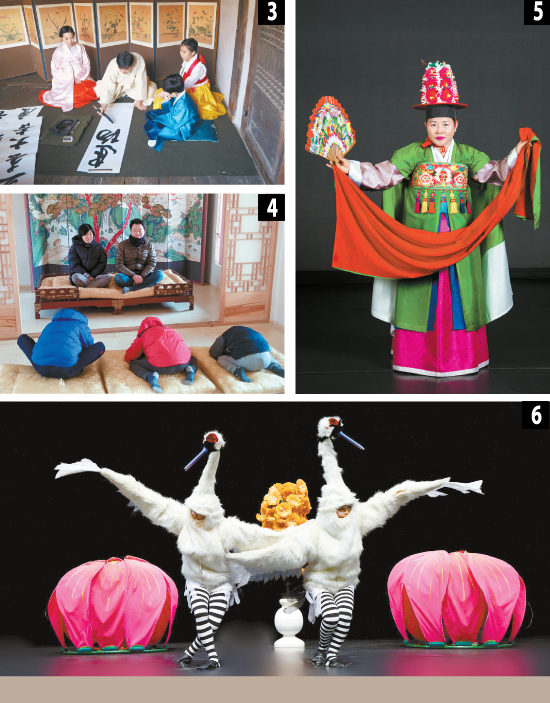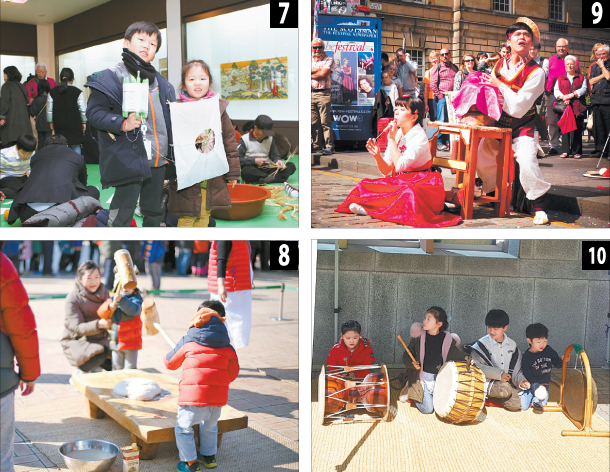Some Lunar New Year fun for the whole family: During Seollal, learn about traditional games, food and more

1 & 2: A traditional performance titled “Arghhh Arirang” by Kkoc doo seh will be staged at the National Museum of Korea’s Open-air Madang on Feb. 6 to celebrate the Lunar New Year holiday. [NATIONAL MUSEUM OF KOREA]
This year’s five-day Seollal holiday kicks off tomorrow, with the actual Lunar New Year Day falling on Feb. 5. National museums across the country, as well as royal palaces in central Seoul are using the nation’s longest holidays as an opportunity to encourage families to be more traditional this year, offering an array of events and traditional performances that children and parents can play and watch together. The museums, however, will be closed on Feb. 5, while the palaces will still be open.
National Museum of Korea, central Seoul
On Feb. 6, the National Museum of Korea is inviting families with children to come and watch a traditional performance titled “Arghhh Arirang” at the museum’s Open-air Madang Gallery at 3 p.m. This traditional performance is presented by the Korean Traditional Performing Arts troupe Kkoc doo seh, which travels across the globe staging various traditional shows. The story of “Arghhh Arirang” revolves around five Arirang singers from five different regions who travel together to perform. Audiences will be able to hear different variations of Arirang, as well as watch traditional dances at the performance, which will be staged for free.
For more information, visit museum.go.kr or call (02) 2077-9000.
National Folk Museum of Korea, central Seoul
Located next to Gyeongbok Palace in central Seoul, the National Folk Museum of Korea focuses on drawing up events both locals and foreigners can enjoy this Lunar New Year. First of all, since 2019 is the Year of the Golden Pig, the museum will offer free bokjumeoni, or a small pouch believed to contain good luck for the year, for those born in the Year of the Pig. This free giveaway will be limited to the first 250 people who come on a first come, first serve basis. They will be available only on Feb. 6 and 7 from 10 a.m. at the entrance of the main building.
Many travelers to Korea try hanbok, or traditional Korean dress, when they visit the royal palaces, but Koreans only wear them on special occasions like Seollal, or Chuseok - Korea’s Thanksgiving. Since hanbok comes with many layers, it’s not easy for first timers to wear it on their own. In the lobby of the museum, there will be a session teaching visitors how to properly wear hanbok, including how to tie the ribbon correctly. Also, they will teach visitors how to perform sebae, one of the most important traditional activities carried out during Lunar New Year, where younger members of the family bow before the oldest members of the family. A well-done sebae may even result in cash in return. This free activity will take place on Feb. 6 from 1 p.m. to 2 p.m. and again at 2:30 p.m. to 3:30 p.m.
If you are a foodie, you can visit the museum on Feb. 6 and 7 to try making tteokguk, a soup made with sticky rice cakes called tteok. This is a dish people eat on New Year’s Day and Koreans believe they get a year older after having a bowl of tteokguk. Today tteokguk comes in many varieties with different broths made from seafood or meat, but in the past, when even a bar of white tteok was expensive, people, especially in the province of North Chungcheong, made what is known as naltteokguk using rice powder instead of tteok to celebrate the new year. The museum has organized a program on how to make naltteokguk on Feb. 6 and 7 from 11 a.m. to 4 p.m. so visitors can experience traditional foods Koreans ate when they were poor but still wanted to celebrate the traditional holiday. This activity costs 4,000 won and registration can be made at the door.
There will be more programs at the National Folk Museum throughout the holiday. For more information, visit www.nfm.go.kr or call (02) 3704-3114.

3: Visitors can try calligraphy at the National Folk Museum of Korea, central Seoul. 4: Children can perform sebae, or the New Year bow, at the Gyeongbok Palace. 5: The Korea House, central Seoul, will invite shamans for the Lunar New Year. 6: The National Gugak Center will stage “Don Taryeong” on Feb. 5 and 6. [EACH ORGANIZATION]
During the Lunar New Year holidays, all four palaces in central Seoul - Gyeongbok, Deoksu, Changdeok, and Gyeonghui - as well as Jongmyo Shrine will be open and there will be no entrance fee at all five sites, the Cultural Heritage Administration announced Tuesday. The administration has also organized traditional activities at several palaces during the holiday period.
Visitors to Gyeongbok Palace will be able to experience the hot ondol (underheating) floor at its Jipgyeongdang Hall. Here, mats will be set up so families who couldn’t perform sebae can do it here, and take traditional looking pictures together. At Deoksu Palace, various activities will be carried out, including jegichagi (a juggling game using one’s feet), tuho (throwing arrows in a basket) and yut (traditional board game).
For more information on Gyeongbok Palace, call (02) 3700-3918 and for Deoksu Palace, call (02) 751-0740.
National Gugak Center, southern Seoul
On Feb. 5 and 6, a traditional performance titled “Don Taryeong” will be staged at 3 p.m. at the National Gugak Center, southern Seoul, to celebrate the Lunar New Year. This performance has been co-created by its residence performance groups, including the Court Music Orchestra, Folk Music Group, Dance Theater, and Contemporary Gugak Orchestra. Members of these groups will all take the stage to showcase various traditional art forms. Prior to the performance, various traditional games and activities will be organized at the center’s Outdoor Experience Plaza, beginning at 1 a.m. All experiences, including tuho, jegichagi and making tteok will be free. Tickets for the traditional performance cost 10,000 won.
For more information visit www.gugak.go.kr or call (02) 580-3300.
Korea House, central Seoul
During the holidays, those interested in getting their fortunes read and praying for a good year can visit the Korea House located in Chungmuro, central Seoul. The Korea Cultural Heritage Foundation announced Tuesday it will hold a unique event this holiday by inviting Korean shamans, known as mudang, to the Korea House from Feb. 3 to 6. They’ll perform gut, or a shamanistic ritual to pray for a good year to the gods. Four shamans, Lee Seong-jae on Feb. 3, Lee Young-hee on Feb. 4, Lee Yong-nyeo on Feb. 5 and Min Hye-kyung on Feb. 6, will perform gut from 2 p.m. to 6 p.m. for four consecutive days. During the gut, the shamans will also tell fortunes to those participating in the ritual. Entrance costs 33,000 won at the door and 25,000 won when booked in advance.
For more information, call (02) 3100-1720 or visit www.chf.or.kr.

7: Visitors can try making a kite at the Jeonju National Museum. 8: Pounding tteok can be tried at the Gyeongju National Museum. 9: A traditional magic show will be showcased at the Gwangju National Museum. 10. Children can learn traditional instruments used in samulnori at the Buyeo National Museum. [EACH MUSEUM]
Known for its traditional villages full of hanok, Jeonju is all set to shine during this traditional holiday. Beginning Saturday, traditional programs at the Jeonju National Museum will run for 17 days, until Feb. 19. There will be traditional games and activities similar to other museums, as well as archery, a large jump rope, hoop rolling, arm wrestling and more. There will also be a special corner filled with games from 1960s and ’70s that may bring back memories for the grandparents visiting the museum.
For those who want to stay inside, family movies will be screened during the holidays. Beginning from Feb. 2, “Boss Baby” will be screened at the museum’s Culture Sarang Hall, followed by “The Nut Job 2: Nutty by Nature” on Feb 3. On Feb. 4, “Coco” will be screened followed by “Despicable Me 3” on Feb. 6. All movies will begin at 11 a.m. There will also be craft classes for those who like to make things. In the lobby of the main building, visitors can make a 2019 calendar on Feb. 2, a New Year greetings card on Feb. 3, bokjumeoni on Feb. 4 and a traditional flower bracelet on Feb. 6. Each program starts at 10:30 a.m.
For more information call (063) 223-5651 or visit jeonju.museum.go.kr.
Gyeongju National Museum, North Gyeongsang
The Gyeongju National Museum will host a Lunar New Year Festival with a variety of interactive events, such as tteokguk tasting, making tteok, colorful sweet rice puffs and traditional tea confectionery, visitors of all ages can experience. Traditional Korean games like tuho, yut and jegichagi - typical Seollal activities - will also be organized at the museum. All events will be held on Feb. 6 from 2 p.m.
Meanwhile, during the holidays, six popular animated movies will be screened from 2 p.m. to 4 p.m. in the museum’s main auditorium.
For more information call (054) 740-7520 or visit gyeongju.museum.go.kr.
Gwangju National Museum
Traditional games will also be organized at the Gwangju National Museum but what this museum offers that others don’t is the samulnori experience. Samulnori is a traditional percussion play that originates from Korea and includes four different instruments and dances. Visitors can learn how to play each instrument and try out playing as an ensemble.
Those interested in fortune telling can experience yutjeom, which is done using yut, and make their own talisman. There will also be a traditional magic show, as well as a number of children’s movies. A special gift awaits guests born in the Year of the Pig who show up at the museum wearing hanbok.
Further information can be found on gwangju.museum.go.kr or by calling (062) 570-7000.
Buyeo National Museum, South Chungcheong
Museum guests and residents of the area around Buyeo National Museum can experience traditional Korean games commonly played during Seollal at this museum and visitors can also try making their own kites and flying them outside on Feb. 4. The tradition of Koreans kite-flying, known as yeonnalligi, dates back to as far as the sixth century A.D. When Koreans fly kites on Seollal, they write their names and birthdays to get rid of bad luck. Many release the kites by cutting the string as there’s an old belief it wards off bad luck in the new year.
For more information on the activities at the Buyeo National Museum, visit buyeo.museum.go.kr.
BY YIM SEUNG-HYE AND LOUISE SCHNEIDER [sharon@joongang.co.kr]










with the Korea JoongAng Daily
To write comments, please log in to one of the accounts.
Standards Board Policy (0/250자)